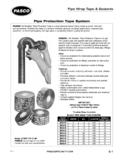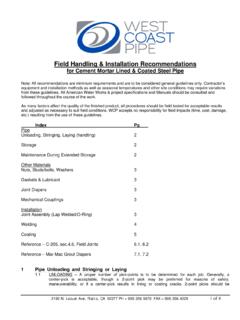Transcription of GUIDANCE INFORMATION ON DESIGN FOR PRESERVATION …
1 GUIDANCE INFORMATION ON DESIGN FOR PRESERVATION AND corrosion control FOR STEEL HULLED VESSELS Prepared by Jim Miller BVT Surface Fleet (Vice Chairman) Marine Painting Forum DESIGN GUIDANCE Marine Painting Forum DESIGN GUIDANCE Marine Painting Forum The Marine Painting Forum membership is drawn from a selection of various companies who have an interest in the supply of coatings, the preparation of surfaces prior to application, the application of these coatings to various structures and the protection media applied to maintain coated surfaces during the build cycle. The membership is not restricted to any one branch of industry but is open to all parties with an interest in PRESERVATION of marine structures. With the exception of our Chairman, David M. Allison , MRINA, RCNC who is an independent member, the current membership is drawn from the following list of companies: Babcock Marine Devonport Limited BMT Sea Tech Limited BVT Surface Fleet (Construction and maintenance) Defence Equipment & Support Hempel Paints Hodge Clemco Limited International Paints Interserve Industrial Services Jack Tighe Limited Leighs Paints PPG PMC (formerly Sigma Paints)
2 Safinah Scangrit Temprotech Limited Marine Painting Forum DESIGN GUIDANCE 1 of 88 Contents 1 Introduction 3 Scope 3 Purpose of the Guide 4 2 corrosion Aspects 5 General Principles 5 Visual Indication of Types of corrosion 9 Other Types of corrosion 16 Principal Methods for Overcoming corrosion 18 3 Structural DESIGN Aspects Guidelines 19 General 19 DESIGN Features to Avoid 19 Access for PRESERVATION 27 Sharp Edges of Structure 28 Tank Stiffeners 29 Corrugated Bulkheads 29 Scalloped Corners 30 Suction Strums 31 Correct Means of Connecting Dissimilar Metals 32 4 Equipment and Component Installation Guidelines 33 General 33 Fasteners 33 Plated Fasteners 34 Deck Equipment/Fittings 35 Internal Equipment/Components 40 Pipes/Fittings in Confined Space 42 Connections to Steel/Aluminium Structures 44 Use of corrosion Resistant Materials 44 Stainless Steels and High Nickel Alloys 44 Copper Based Alloys 46 Titanium 47 Aluminium Alloy 48 Fibre Reinforced Plastic 48 5 Surface Preparation Prior to PRESERVATION 49 General Techniques 49 Standards 50 Containment 51 Blast Media 54 Marine Painting Forum DESIGN GUIDANCE 2 of 88 6 Application of Different PRESERVATION for corrosion control 73 General 73 Requirements for Painting 73 Paint Application 74 Occupational Hygienic Considerations 75 Type of Paint Coating 76 Maintenance Painting 76 Powder Coatings 77 Summary 78 7 Quality control 78 Measurement of Dry Film Thickness 79 8 Protection During Build/Refit 83 9 Related Documents 86 Marine Painting Forum DESIGN GUIDANCE 3 of 88 1.
3 Introduction Scope This document is intended to be used as an aid to naval ships staff, shipbuilders and ship repairers, concerned with DESIGN , PRESERVATION , ship husbandry and repair of ships and submarine structures. It provides general GUIDANCE and INFORMATION on: The identification of corrosion mechanisms. Potential problem areas. Methods of improving corrosion performance. Current good DESIGN practice. Selection of materials. Although corrosion problems in the ships and submarines are generally well understood and documented, the associated financial issues are less well appreciated. Much can be achieved at the DESIGN & build stage, to reduce the in-service ship husbandry workload and to maintain structural integrity, by paying much closer attention to detailed DESIGN and PRESERVATION issues. Marine Painting Forum DESIGN GUIDANCE 4 of 88 Purpose The purpose of this GUIDANCE document is to outline the general principles of corrosion and the various methods used to control it.
4 Whilst the INFORMATION is presented in the context of naval vessel construction and reflects current best practice, the underlying principals remain relevant to both the merchant fleet and static salt water based steel platforms. More detailed documents are referenced where appropriate. In general, this document is aimed at steel hulled vessels however many of the basic principals are pertinent to both aluminium and FRP/GRP hulled vessels. This document addresses: The types of corrosion which occur with the materials used for ship and submarine construction Specific detail concerning equipment installation to the steel structure. Surface preparation required prior to applying PRESERVATION treatments Structural aspects of DESIGN for avoiding corrosion and simplifying the application of coatings and maintenance Marine Painting Forum DESIGN GUIDANCE 5 of 88 2 corrosion Aspects General Principles Most metals occur in nature as oxides or complex salts and the metal is extracted through the expenditure of considerable amounts of energy.
5 Therefore, there is a tendency for them to try to revert to their natural state and this process is known as corrosion . corrosion is the degradation of the exposed surface of a metal due to reaction with its environment. Under atmospheric conditions metal surfaces are covered with a corrosion product which is thermodynamically stable with the environment. This mainly consists of an oxide but generally includes compounds containing atmospheric impurities such as sulphur, chlorides and water. This oxide can be thin and impervious where it becomes protective on titanium alloys, aluminium alloys or stainless steels. In other cases the oxide is porous and not protective rust on steel in damp air. For steels immersed in water, regions of corrosion , passivation and immunity can be related to its potential LE and the pH of the environment in a Pourbaix diagram as shown in Figure Figure Simplified POURBAIX diagram (Potential/pH) for Fe-H20 System showing regions of immunity, passivation and corrosion .
6 Here the oxide is not stable and corrosion of steel will occur in acids (low pH) and in strong caustic (high pH). Also there is a potential (voltage) below which steel is immune to corrosion . Marine Painting Forum DESIGN GUIDANCE 6 of 88 There are conditions, with metals which are normally corrosion resistant, where the oxide cannot be repaired because there is insufficient oxygen or the oxide is not stable in a particular environment such as acids and corrosion will occur. This is the driving force behind the mechanism of crevice corrosion . Protective oxide films can be broken down by aggressive species such as chlorides, fluorides and sulphur, where local galvanic cells are set up on the metal surface and highly acidic conditions can occur at the site of the local contamination due to formation of, for example hydrochloric acid, hydrofluoric acid or sulphuric acid and localised corrosion occurs as indicated in Figure This is the main cause of pitting.
7 Combinations of metals can also result in corrosion problems. All metals when immersed in an electrolyte adopt a potential which is a voltage quoted against a standard reference electrode ( silver/silver chloride or calomel) For steels in sea water at pH8 this potential is between -600 to -700 mV against a calomel reference electrode. In Figure Iron can be made immune to corrosion by lowering the voltage to -800mV ( volts) at pH s below 10. The potentials in sea water for a range of metals can be listed to form a galvanic series (quoted against a calomel reference electrode) see Figure It should be noted that potentials vary with changes in flow rate and temperatures. An example is the polarity reversal in certain domestic water systems between zinc and steel at temperatures above 600C leading to rapid corrosion of the steel Marine Painting Forum DESIGN GUIDANCE 7 of 88 Volts Saturated Calomel Half-Cell Reference Electrode Volts vs.
8 Std. Hydrogen Sat. Cu/CuSO4 Sat Calomel. (also Ag/AgCl in 20 ohm-cm seawater) Figure Alloys are listed in order of the potential they exhibit in flowing sea water. Certain alloys indicated by the symbol: in low-velocity or poorly aerated water, and at Marine Painting Forum DESIGN GUIDANCE 8 of 88 shielded areas, may become active and exhibit a potential near volts Figure When metals of dissimilar electrochemical potential are electrically coupled together in the presence of a conducting electrolyte such as sea water the more negative, or active, of the two metals will corrode at an accelerated rate. The more positive, or noble, of the two metals will not suffer from corrosion . This mechanism is called galvanic corrosion . The mechanism of galvanic corrosion , illustrated by the electrochemical cell in Figure , comprises of four essential components: a. ANODE - a metal which is more negative, or active, than the cathode.
9 B. CATHODE - a second metal which is more positive, or noble, than the anode. c. ELECTROLYTE - a solution which is capable of carrying an electrical current between the anode and cathode, sea water. d. ELECTRICAL PATH - an electrically conducting path between the anode and the cathode Important applications in relation to steel are: a Steel can be prevented from corroding by connecting it to a less noble metal or lowering the potential into the immune region of Figure This is the principle of cathodic protection by sacrificial anodes, or impressed current (IC) systems. b Scale formed on steel arising from the manufacturing process is electrically conducting and very noble and can cause severe corrosion of the steel. These must be removed prior to any preservative treatment. c corrosion can be prevented through keeping the environment away from the steel surface by using coatings.
10 D Steel can be prevented from corroding by the application of hot spraying of organic metals zinc or aluminium. Marine Painting Forum DESIGN GUIDANCE 9 of 88 Visual Indication of Types of corrosion Types of corrosion : there are several types of corrosion , the most common found are summarised below. More details on definitions and examples are highlighted on paragraphs 2-6 to 2-1 1. Common types of corrosion found topside are: 1. Uniform or General corrosion 2. Pitting corrosion 3. Crevice corrosion 4. Galvanic corrosion 5. Exfoliation Marine Painting Forum DESIGN GUIDANCE 10 of 88 UNIFORM corrosion DEFINITION: Uniform attack over large areas of metal surface. Generally due to the presence of moisture and oxygen. Therefore this is the most common form of corrosion over a large area. EXAMPLES: 1 Uniform rusting of unpainted or poorly painted steel 2 Rusting of inaccessible deck/bulkhead 3 Rusting of poorly preserved wet spaces 4 Rusted fasteners CAUSES: 1 corrosion builds up on the entire surface due to formation of a non protective oxide.








